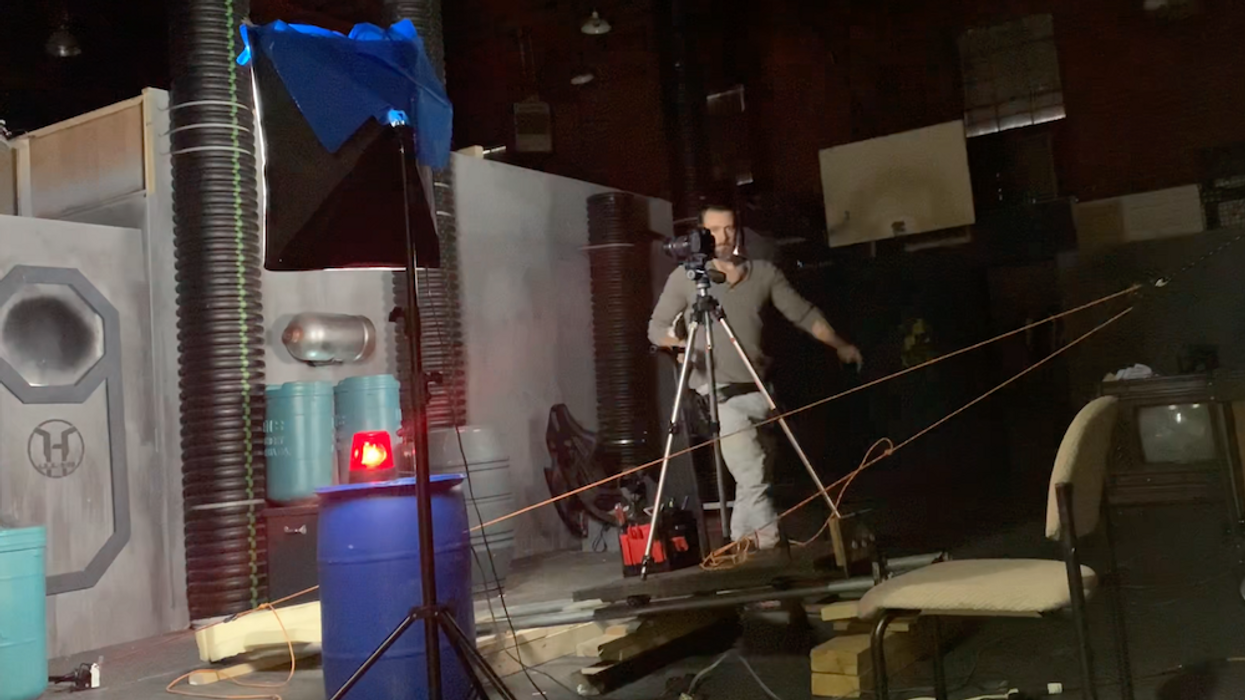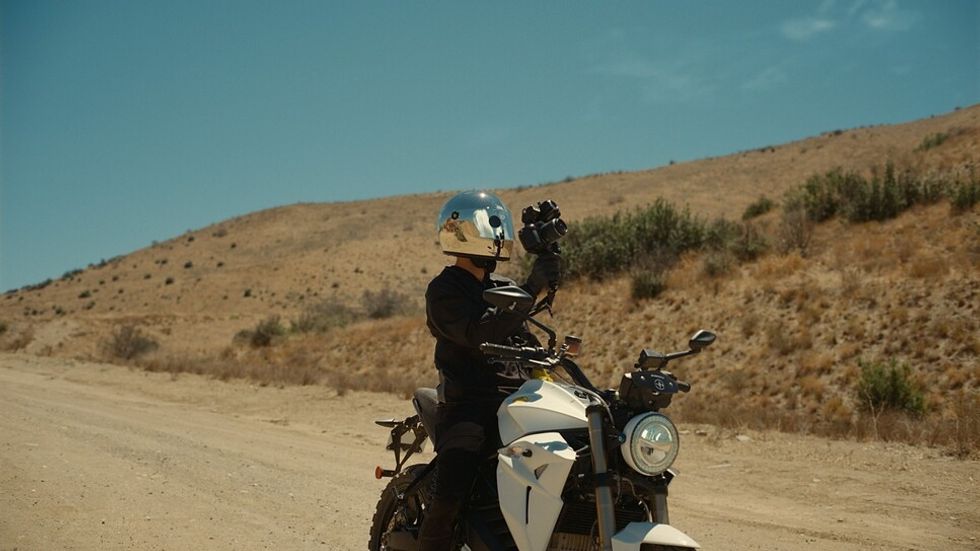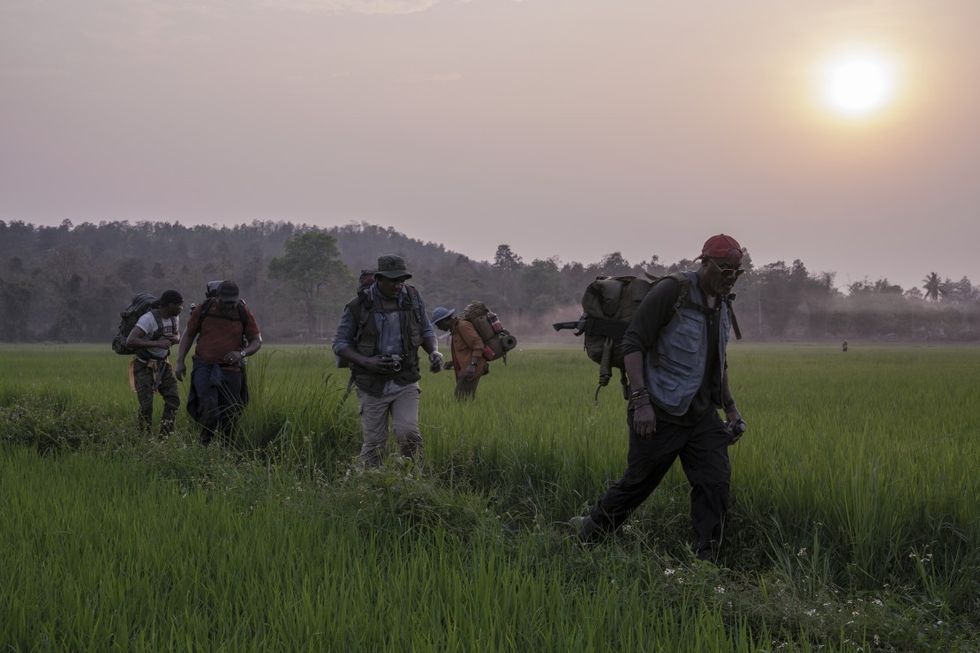I Made a Sci-Fi Short by Myself—Here Are Creative Tips for Any Solo Project
Alone, quarantined with a dog on an abandoned sci-fi set. Could you shoot a short film all by yourself?

This post was written by Jason Skeen.
We all had plans. Some of us were planning amazing vacations, while others were starting their first business or planning to spend more time with an ailing family member. We all had plans, and just like that—they were altered.
My altered plans had me living in a small South Georgia town in an old abandoned school gym that was the former set of a sci-fi movie. Or, as I prefer to say, “Living on a spaceship!”
The exact story of how I came to spend 9 months during a pandemic on a former sci-fi movie set would be best left for a memoir. I was fortunate enough to have my best four-legged friend, Luke, with me the whole time. He is also my co-star and a scene-stealer. Seriously, he can steal a scene with a look. Lucky dog!
When lockdowns started, a lot of competitions came up for filmmakers to make short films where they were quarantined, such as the one from We Are Films out of New York. What a great idea! I knew being on a film set would be a huge advantage.
The only problem was, I’m an actor, not a cinematographer. I needed my friends to help, but no dice. So I rewrote my script for one man and one dog.
I wanted to share my behind-the-scenes process for you here and go into a little step-by-step. Check it out.
Personal inventory
Here's what I had on hand to start this project.
- Canon 60D
- Canon lens 28-135mm
- Manfrotto Tripod (no fluid head)
- ASUS sound mixer
The only thing left to figure out was how to get interesting shots with no camera operator.
I have to make the camera move, I thought. But how?
I began taking inventory around the set, which wasn’t in an actual studio so there was no equipment. However, there were a bunch of random items that people from the local community had donated for the last movie. These were treasures to me. But If I was going to make the camera move, I needed wheels. That's when I found...
Use a broken skateboard
The tail had been snapped off and the whole thing discarded, but the wheels were perfect. I drilled a hole and mounted my tripod head. For the tracks, I found some OSB scraps and two sawhorses.
Then came the problem of moving the skateboard while being in front of the camera. I had a failed attempt with a pulley and some rope. There was not enough control. So I had to come up with something else. I looked and looked hoping I would get an idea. This whole thing was almost over before it began.
Then I literally stumbled onto an idea. In frustration, I turned to kick what just tripped me, and then I saw it—my salvation, a furniture dolly.
It was broken completely in half but the casters could be salvaged. I took off one caster, removed the wheel, ground down the points, and attached it to the underside of the skateboard. Next, I found an old piece of PVC pipe and attached it to the caster. Finally, I had full control of the camera. At least for medium and close-up shots.
So, what did I do with the rope and pulley? I almost discarded them, but lines from The Boondock Saints kept playing in my mind.
“Name one thing you’ll need a rope for.”
“You never know why you need it, you just always need it!”
Obviously edited for the TV version. So I kept them close by just in case.

Miscellaneous items found
Here are the other things I cobbled together from the set.
- Softbox light
- Two work clamp lights
- Tripod with broken head (used as my stand-in to get focus)
- Blue plastic static sheet (used as a blue gel)
- Wax paper (used as diffusion)
- Sony corded body mic (Although not wireless, this was priceless for sound)
- Various small LEDs (for accent lights)
I find it more interesting if a scene starts with movement, and while the skateboard dolly/slider was great for mediums and close-ups, I still needed more variety. The only other option was a locked-off shot of Luke or me walking into frame, which I used but I wanted more.
So a-scavenging I go! By this time people had been dropping off donations outside or in some cases, “Here, you throw this away.”
One such item appeared to be just some scrap wood, until I turned it over and found it was something more valuable.

Do-it-yourself dolly
It was a dolly that my tripod would fit on. I found out later that a local videographer had built it to hold an actor to do a levitating effect. It didn’t have tracks with it so I kept looking and found two long top rails from a chain-link fence and paired it with some scrap lumber for support.
Now that I had this larger dolly, how was I going to use it? I could use it for POV and push-ins during cutaways, sure. But, what about following me?
I added a piece of plywood to the front with some L-brackets and created a push plate. Then I made a harness out of some belts and a holster and I added an aluminum pole from a broken backdrop. Now I could push it while walking toward it.
Next, I fastened another L-bracket to the end of the pole, so now I could pull the dolly behind me.
At this point, I wanted to challenge myself even more. I admit I got a little ridiculous.
First, I wanted the camera to push in as I walked forward. No, too easy. Let’s push in while I walk forward while shooting through a porthole window from behind a door. Part of me was saying, Shut up, stupid, and be happy with what you’ve got. The other part of me was drunk on power. This must be how MacGyver felt.

Grabbing the pulley and the rope and putting the dolly on an incline, I could make the dolly move forward with the help of gravity. The tricky part was how to release it from behind a door. I reused the pole that pushed the dolly, to run through a gap in the door. This gave me a lever. Then with the help of a simple figure-8 knot and a bungee cord, I now had the release mechanism. It took some trial and error, and I had to time my walk, but in the end, it worked out.
With these two contraptions, I could push, pull, follow, and track. I guess I’m greedy because I wanted to have some rising shots as well. I needed a boom. I tried using my tripod, but without a fluid head, it was beyond my capacity to figure out how to make it smooth and safe. I decided to go back and write another scene.
While I was writing, I stopped and leaned back in my chair to think. Like a child, I began playing with the release lever on the chair. I pulled it and I would glide down. Then I would stand, reset it, and repeat. Up and down trying to think of how the story would go. This went on until finally an epiphany. I hit the bottom, stopped, and the answer to my boom was right under me.

My chair boom
This felt really stupid, but with no one around to judge me and my curiosity burning, I had to try it.
First, I tied down the release so that the chair wouldn’t lock at the bottom. Then I used another rope to cinch the chair in place and held it there with a spring clamp. Next, I tied a piece of string to the clamp and ran it to where I would be standing. Now, I had a release lever Rube Goldberg would be proud of.
The only problem was the movement was short, and because I couldn’t make the chair taller, I decided to add another movement. Taking the bungee from earlier, I connected it to the base of the chair and the other end to the tripod head at an offset. So at the bottom of the movement, the bungee would have slack in it, and as it rose the tension in the bungee would begin to turn the chair. This created a boom and pan effect.
The difficult part was acting while using my peripheral vision to time my movement with the pan. After a couple of practice runs, I got it.

And really, isn’t that why we do this? Doesn’t the creative imagination ignite the passion in all of us? When we run into obstacles do we go around them or use them to challenge us to be better, to do better?
Frank Lloyd Wright once said, “The human race built most nobly when limitations were greatest and therefore most was required of imagination in order to build at all.”
While what I did is no example of world-class architecture, I do understand this quote more personally now.























